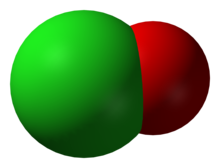Hypohalites

Hypohalites are salts of hypohalous acids ( hypochlorous acid , hypobromous acid or hypoiodous acid ), whereby the salts of hypochlorous acid HClO (formerly also called hypochlorous acid ) have the greatest practical importance, for example sodium hypochlorite or potassium hypochlorite . These salts contain the ion ClO - . Chlorine is in the +1 oxidation state . Similarly, the salts of the hypobromous acid HBrO contain the hypobromite ion BrO - . Bromine is in the +1 oxidation state . The salts of the hypoiodous acid HIO contain the hypoiodite ion IO - . Iodine is also in the +1 oxidation state.
The organic hypochlorites R – OCl are very unstable.
use
Hypochlorites are used for bleaching and disinfecting , see also Javel water ("Eau de Javelle", an aqueous solution of potassium hypochlorite ) and "Eau de Labarraque" (aqueous solution of sodium hypochlorite ). Hypochlorite solutions are also used to deodorize waste water from chemical production processes.
Hypobromites are used in quantitative analytical chemistry as oxidizing agents such. B. used in the precipitation of manganese and nickel salts. Other hypohalites are of subordinate importance.
Individual evidence
- ^ A b Brockhaus ABC Chemie , VEB FA Brockhaus Verlag Leipzig 1965, p. 569.
- ↑ Otto-Albrecht Neumüller (Ed.): Römpps Chemie-Lexikon. Volume 3: H-L. 8th revised and expanded edition. Franckh'sche Verlagshandlung, Stuttgart 1983, ISBN 3-440-04513-7 , p. 1820.
- ↑ Otto-Albrecht Neumüller (Ed.): Römpps Chemie-Lexikon. Volume 2: Cm-G. 8th revised and expanded edition. Franckh'sche Verlagshandlung, Stuttgart 1981, ISBN 3-440-04512-9 , pp. 898-899.